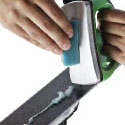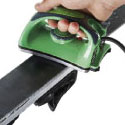A collection of training videos & tutorials.
Find the right wax for the right conditions.
Racing wax for Snowboarding & Skiing.
Use the same tools the pro’s use.
Wax Application
Short Overview with Demonstration of Hot-Wax-Scrape Cleaning (at 5 min mark)
Extended & Very Detailed Overview
This section includes: Applying Wax ::: Iron Temperatures ::: Roto-Brushing
Before You Start
Some things to keep in mind:
- If new, confirm that the structure of your base is appropriate for the snow conditions. See the Structure Theory section.
- Clean your base (brush out old wax and hot wax scrape - avoid overuse of chemical cleaners! - hot-wax-scraping (preferred) is described in the "before applying wax" section).
- Your skis/board should be at room temperature before you wax.
- Sharpen edges before you start this section. See the Edge Tuning section.
- The basic idea is to work your wax in (your base is porous that can soak up wax to act as a reservoir while racing); then brush out excess wax to expose the base structure.
- General Rule #3: You want wax in your base, not on your base.
- Bases are made of sintered p-tex that contain microscopic voids that can absorb wax.
- Let the base cool before brushing because the cooling will squeeze wax out of the base.
- Keep the base saturated with wax to avoid oxidation (base burn). White areas on the base are most often a dry base that is in need of wax. However, white spots that do not absorb wax are an indication of base burn (oxidation).


Applying Wax
- Protect your bindings from wax drippings with tape. White Toko tape (FD-1219) is great for this. Tape over everything but the edge. You can even tape over your vise.
- Set your ski in a vise and hold the brakes back with a brake retainer. It's easier to clamp the binding rather than the side wall.
- Start with a firm brushing of the base with a stiff brass brush (at least) or a steel brush. Care and experience is required here because a sharp/coarse brush can ruin a base. If the bristles are sharp, dull them with a file and test on old skis first. (better choice, especially for harder [cold temp] waxes) to remove oxidation and expose the base structure clogged with dirt & old wax.
- Do this from tail to tip. Yes, it is not a typo, tail to tip. You need to remove wax from the structure. If your brush is sharp or very stiff, make sure you use enough pressure to remove wax, but not so much as to damage the base structure. Do three full length passes. Break the ski into thirds and work each third three times. Do a clean up brushing with the brass brush. Use a sharp scraper to remove any base material hairs.
- NOTE: Remember to keep the surface of the iron clean. To clean the iron, use a light sandpaper if necessary, run the hot iron over clean shop towels on a flat surface. You can also use a cheap yellow wax to clean up the surface.
"Crayoning" Method for Conserving Wax or RaceWax Fluoro Wax Application
Hot-Wax-Scrape Base Cleaning
- Use the hot-scrape method to completely clean the base of old wax before you add new wax. The idea is to use warm/liquefied wax to "rinse out" the dirt and old wax.
- Choose an inexpensive soft wax; a warm rated yellow or red hydrocarbon wax is ideal for this.
- Drip on a coat of wax
- You want a warmer iron for this step so as to scrape it off while it is still liquid. You should have a 8+ inch trail of liquid wax behind the iron without overheating the base.
- Some people monitor the temperature by touching the top of the ski (which is now under the base); keep in mind that the thermal properties of skis (how well heat passes through from base to top) differs from ski-to-ski because the layers may have different thicknesses or materials that can vary in how they insulate or conduct, so for some skis a feeling of warmth or a lack of warmth may be a false indicator, and in fact too hot.
- Repeat waxing/scraping until the scraped-off wax is clean.
- Select a wax for the final wax/scrape that is closer to the temperature of your race wax; select a warm or cold version.
- After your last scraping, brush with a nylon brush; you don't have to wait for the wax to fully cool for this step.
Cold Powder Application for Preventing Base Burn
Wax for Speed
- The crayon method saves wax.
- Apply wax as stated above and iron the wax in.
- NOTE 4: If your iron isn't calibrated what you dial in may not be the exact temperature of the iron. Use the temperature numbers (at the bottom of this page) as a guide and adjust down to the lowest temperature that will maintain the wax in a liquid state in a 4 inch trail behind your iron. A smoking wax is too hot!
- Keep the iron moving at all times to avoid burning the base.
- Keep the wax warm state for about 3 minutes per ski by passing the iron over the ski repeatedly.
- NOTE 5: Temperatures above 140 Celsius (284 Fahrenheit) can burn the base. For cold waxes that require a hot iron, make sure you have dripped or rubbed on wax so there are no bare spots on the base. If you have fiberlene paper, use that between the iron and your base.
- NOTE 6: If you are going to a race and need to travel, it is preferable to wax at your destination if you do not have a car-top carrier or case to protect your skis. If you skis will be exposed on your rooftop, make sure they have a coat of wax (use a cold wax if the weather is cold) on them and rub a wax over the metal edges so they don't rust from road salt.
- Let ski cool. This takes 30-60 minutes. The idea is that when the ski cools, the wax bleeds out of the base. So if you didn't let it cool before you brushed/buffed it, then the wax will bleed when you get it out on the snow; if this happens the excess wax will clog your structured channels. Actually, this may still happen anyway, so a horsehair brush for brushing before the race start is handy.
- Don't cool fast (e.g., don't put them outside in the cold); it closes up your pores quickly and the wax is forced out.
- Let the ski cool at room temperature.
- Scrape excess wax with a plexi scraper using light strokes.
- If you are using a very hard Swix CH4-5 wax, do not wait until the wax hardens (and it hardens very fast). Scrape the wax while it is still slightly warm to avoid chipping the wax.
- NOTE 7: You want to brush and scrape until there is no more wax on the surface or the structure. The key to fast bases is to brush, brush and then brush more!
- Brush 5-10 times with a nylon brush.
- Cold waxes need stiffer brushes. The progression of brushes is (stiffest to softest) Steel > Brass/Copper > Nylon > Horsehair. For the last three there are 9 mm and 18 mm versions; the 18 mm is softer than the 9 mm. If you are using rotobrushes, see the notes at the end of this page.
- A steel brush is for cleaning (prior to waxing) and is best used by experienced tuners as it is very aggressive.
- Brush next 10-20 times with a horsehair brush to pull out more wax and polish.
- Buff with an 18 mm horsehair brush (DrD's favorite) or fiberlene paper.
- A cheap plastic kitchen scrubbie (mesh plastic "sponge") is great for cleaning up wax drippings on the skis and in the work area.
NOTE: When you get out to the slopes and your ski/board cools down, wax can bleed out of the base and clog the structure. Lay them on the snow for 20 minutes or longer. Take a horsehair brush with you to do more brushing of the base before the race.
Between Races
Roto-Brushing
Don't use excessive drill speeds or downward pressure. Excessive drill speeds can lead to bristle loss. This will create excessive heat and smear wax rather than brush it. Most cordless drills max out at 1,200 rpm, but standard drills go up to 2,500 rpm. Use the sound of the drill to judge the speed.
- Always use safety glasses.
- A respirator or any kind of dust mask is good to avoid breathing the dust.
- Brush with the brush rotation throwing the wax particles away from you.
- Brass Roto-Brush: Use at a medium pace with light pressure at 800 rpm.
- For RaceWax brushes use Nylon before Horsehair. Swix recommends the opposite (you'll have to ask them why). We recommend Nylon first because it more efficiently removes wax (which is the goal of the first brush), and Horsehair second because it has a finer bristle that removes wax from the now exposed fine structure of the base, and is the best brush for the final finish.
- Nylon Roto-Brush: Use at a medium pace with medium pressure at top speed not-to-exceed 1,200 rpm.
- Horsehair Roto-Brush: Use at a medium pace with light pressure at top speed not-to-exceed 1,200 rpm, until no more wax comes up.
- Felt Roto-Brush: Use back and forth at a medium pace with light pressure at top speed not-to-exceed 1,200 rpm.
- Using a Roto-Cork to add wax: Lightly crayon wax onto the base; apply a thin even layer. Use back and forth at a quick pace with very light pressure at 800 rpm, finish with hand corking. Due to the extreme heat generated by friction minimize the time the cork is in contact with the base. There is no need for a finishing stroke.
Iron Temperature Chart
If your iron isn't calibrated, what you dial in may not be the exact temperature of the iron. Use these numbers as a guide and adjust down to the lowest temperature that will maintain the wax in a liquid state at a length of about 4 inches (10 cm) behind your iron. Using your judgment is always preferred to relying on the dial setting. Here are some general guidelines for wax iron settings.
| Wax Temperature (F) | Iron Temp (F) | Iron Temp (C) |
| Warm | 230 | 110 |
| Cold/All-Temp | 265 | 130 |
| >32 | 230 | 110 |
| 25 - 34 | 240 | 115 |
| 20 - 28 | 255 | 125 |
| 15 - 21 | 265 | 130 |
| <21 | 275 | 135 |
| <15 | 285 | 140 |
Note: At 285 F / 140 C you should be using fiberlene between your base and the iron to prevent base damage.
- Wax Wizard
- Tuning Tips
- Tuning Tips Overview
- Quick Tuning Guide
- Base Structure Theory
- Edge Tuning
- Ptex Base Repair
- Diamond Stone Care & Use
- Sidewall Cutting
- Wax Application
- Wax Iron Setting
- Choosing Wax
- Wax Charts
- Choosing Tuning Kits
- Tuning Kit Instructions
- Essential Equipment List
- Powder Application
- New Skis/Board Care
- Spring Tuneup
- Summer Storage
- Buying at Ski Swap Sales
- Questions and Answers
- Video Archive Overview
- Newsletter Signup
